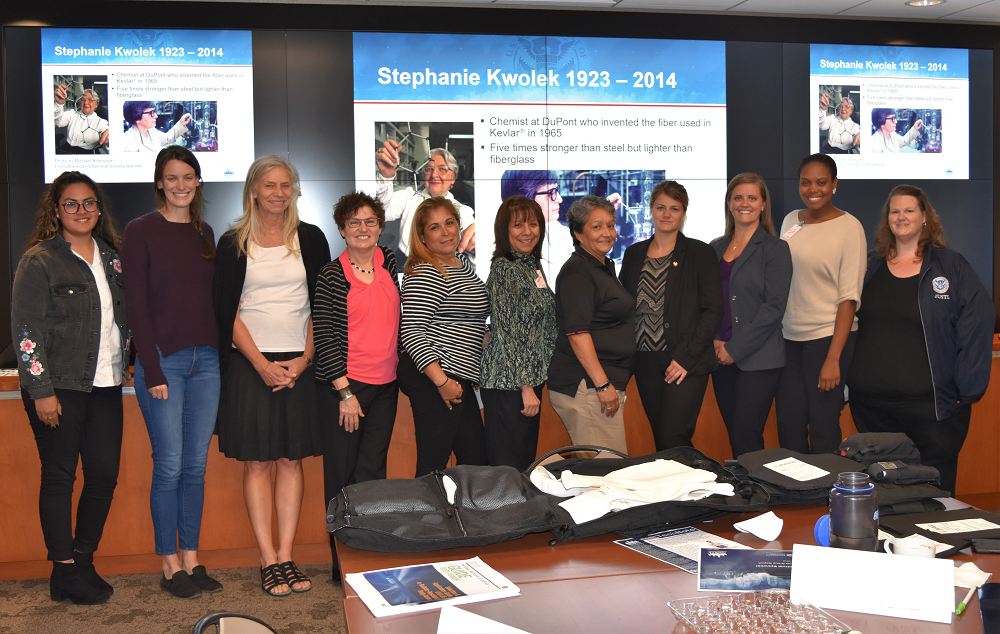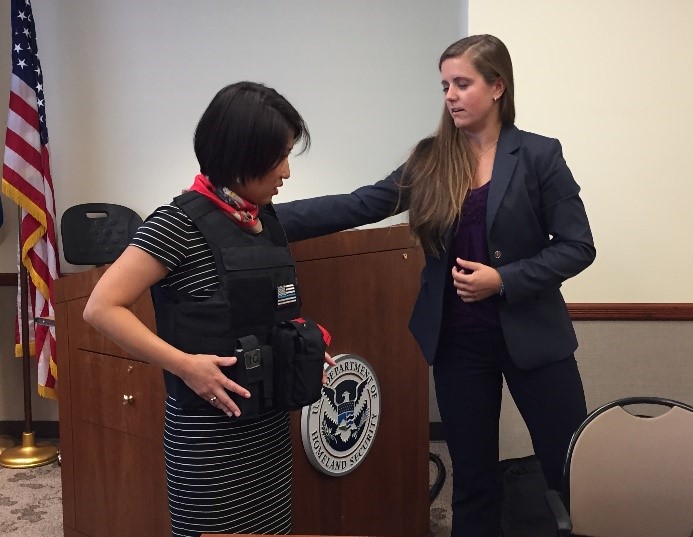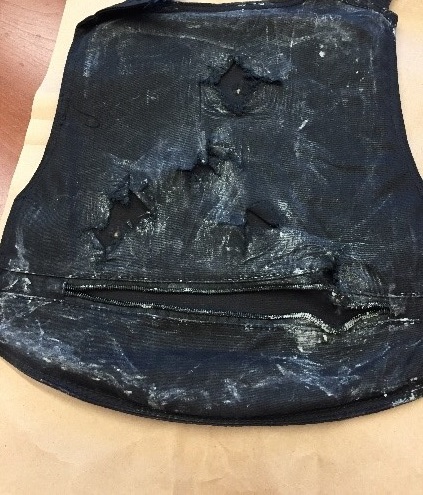
Law enforcement in the United States remains a male-dominated profession. According to recent reports published by the Department of Justice (PDF, 670KB, 44pgs.) and Statista, less than 13% of full-time officers are female. So, it stands to reason that the ballistic-resistant body armor worn by law enforcement officers in the field has traditionally been designed for the male build. As the number of women entering the field continues to rise, so too has the demand for personal protective equipment (PPE) that is designed for the female physique to ensure women are as safe, efficient, and comfortable as men while on the job.
Who better then to study the best body armor on the market for these women who put their lives on the line every day? And who better to revisit the operational requirements for design, form, fit, and function? That’s right: women in science.
Fun fact: did you know that it was a woman—Stephanie Kwolek, a chemist for DuPont—who invented the technology behind Kevlar, the synthetic fiber commonly used to make the bullet resistant vests that protect vital organs from ballistic threats during incidents involving firearms? And in September 2019, it was five women from the Department of Homeland Security (DHS) Science and Technology Directorate’s (S&T) National Urban Security Technology Laboratory (NUSTL) who embarked on a project to assess the capability, usability, deployability, maintainability, and affordability of various makes and models of female body armor.
“The development of performance requirements and test methods for ballistic-resistant body armor for women was identified as a priority by the Interagency Board, a collaborative panel of emergency preparedness and response practitioners,” stated Kris Dooley, NUSTL program analyst. “Females are expected to perform the same duties as their male counterparts, so it’s important to ensure that their body armor is optimized to offer the same level of protection.”
To start, NUSTL’s System Assessment and Validation for Emergency Responders (SAVER) program convened a focus group of female first responders from several states to obtain their expert recommendations for evaluation criteria, product selection, and operational scenarios. Because the responders use ballistic-resistant body armor in daily operations, their input is critical to ensure that the right models are tested, and that they are assessed in true-to-life environments. All of their initial input is available now in NUSTL’s recently-published focus group report, which will serve as the basis for evaluating several PPE models during an upcoming assessment.
“I was very impressed by how women in law enforcement are able to handle many of the difficulties caused by wearing body armor that is mainly designed for men,” said NUSTL chemist Karin Decker. “They are often uncomfortable and not fully protected while on the job. Many of the women purchase their own better-fitting and more functional armor, which may or may not meet specifications for ballistic protection.”
For Women in Law Enforcement, There’s Not Always a Universal Body Armor Solution
Existing body armor that female officers wear in the field tends to either be gender-neutral, meaning it can be worn by any officer, or it has a three-dimensional structure (using folds, darts, or seams to create cup shapes) intended to curve and fit around the bust line. Focus group participants noted that in their experience, these designs do not conform well to their body contours.
 “It’s extremely important that a ballistic-resistant vest be the right fit for my body type. We come in various shapes and the one-size-fits-all is not safe for women,” said focus group participant Angela Alonzo, Special Agent (retired), DHS Immigration and Customs Enforcement Homeland Security Investigations. “At the end of the day, I want to go home to my family.”
“It’s extremely important that a ballistic-resistant vest be the right fit for my body type. We come in various shapes and the one-size-fits-all is not safe for women,” said focus group participant Angela Alonzo, Special Agent (retired), DHS Immigration and Customs Enforcement Homeland Security Investigations. “At the end of the day, I want to go home to my family.”
For NUSTL, providing an opportunity for female responders to assess several currently-available body armor options will ultimately allow response agencies to purchase the right PPE for their officers. The focus group was held to learn from the users’ practical experiences what features are important to include in the assessment.
“The focus group taught us that many first responder fields and disciplines are not prepared to offer women adequate protective equipment,” said NUSTL engineer Brenda Velasco-Lopez. “I believe that women in science can find a solution not only for ballistic-resistant body armor for law enforcement, but also for other areas of response that may lack adequate PPE for women. It is important that we do everything we can for those who risk their lives to protect our communities every day.”
Focus group participants identified 21 different evaluation criteria and determined that first and foremost, usability and capability—not affordability—are the most important factors to consider in assessing the garments, though cost, ease of deploying, and ease of maintenance will be taken into account. Regarding design, assessment criteria will include belt- and vest-compatibility, comfort, cup size, fit measurement process, female design fit, non-prohibitive movement, and closure direction.
“Being able to work with law enforcement officers in this environment provides insight that would be difficult to gain elsewhere,” said NUSTL Program Manager Gladys Klemic, who led the focus group.
New Standards for Ballistic Resistance of Female Body Armor are Forthcoming
The National Institute of Justice (NIJ) is the main authority for establishing and updating performance standards for body armor, and work is currently underway to revise the Ballistic Resistance of Body Armor Standard 0101.06 (PDF, 1.56 MB, 89 pgs.)to update ballistic threat categories and to ensure female-designated body armor provides adequate protection. The standard was originally approved in 2008, and the NIJ National Law Enforcement and Corrections Technology Center’s Body Armor Compliance Testing Program (CTP) released an Administration Clarification document in 2015 focusing on flexible ballistic-resistant body armor containing two panel designs typically used in body armor optimized for women. The updated standard is expected to be released later this year.
 CTP Criminal Justice Testing and Evaluation Consortium Operations Manager Alex Sundstrom attended the September focus group to discuss the revised standard, which will ultimately inform NUSTL’s selection of body armor products for the SAVER operational assessment—only products certified NIJ-compliant will be included in the assessment. He discussed NIJ’s laboratory performance testing processes and highlighted new test specifications that address body armor specifically designed for women. For instance, the revised standard will include additional specifications to account for potential weak points at armor seams and will increase the number of armor panel samples tested to provide adequate statistics for curved front panels.
CTP Criminal Justice Testing and Evaluation Consortium Operations Manager Alex Sundstrom attended the September focus group to discuss the revised standard, which will ultimately inform NUSTL’s selection of body armor products for the SAVER operational assessment—only products certified NIJ-compliant will be included in the assessment. He discussed NIJ’s laboratory performance testing processes and highlighted new test specifications that address body armor specifically designed for women. For instance, the revised standard will include additional specifications to account for potential weak points at armor seams and will increase the number of armor panel samples tested to provide adequate statistics for curved front panels.
“One of the most important things an agency can do is make sure the armor they purchase is listed on the NIJ Compliant Product List. All armor models on the list have demonstrated ballistic performance in accordance with the requirements in the NIJ standard and the requirements of the NIJ CTP,” said Sundstrom.
“Additionally, participating in this focus group to plan the assessment helped reinforce the need for agencies to take steps to make sure armor fits each individual end user to ensure the proper coverage,” Sundstrom continued. “Not only should this make the armor more comfortable to wear, but it will help armor perform the way it was intended.”
Assessment will Focus on Input of End-users who Wear Armor Every Day
NUSTL’s Body Armor for Women assessment will complement the certification program by addressing the practical aspects and experiences of women wearing armor. It will take place after the release of the new NIJ standard and associated product certification and will include female law enforcement officers of all shapes, sizes, ages, and levels of professional experience. Related information will be posted to the SAVER publication library on the S&T website.
“We get to know law enforcement officers on a human level—they give us great perspective into their lives beyond their uniforms. All of these are elements that make us strive to do our jobs to the best of our ability to help responders make the most informed decisions possible when acquiring new protective equipment,” said Dooley.

